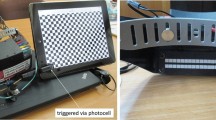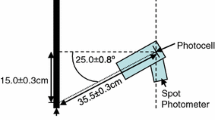Abstract
There are several electrophysiological systems available commercially. Usually, control groups are required to compare their results, due to the differences between display types. Our aim was to examine the differences between CRT and LCD/TFT stimulators used in pattern VEP responses performed according to the ISCEV standards. We also aimed to check different contrast values toward thresholds. In order to obtain more precise results, we intended to measure the intensity and temporal response characteristics of the monitors with photometric methods. To record VEP signals, a Roland RetiPort electrophysiological system was used. The pattern VEP tests were carried out according to ISCEV protocols on a CRT and a TFT monitor consecutively. Achromatic checkerboard pattern was used at three different contrast levels (maximal, 75, 25%) using 1° and 15′ check sizes. Both CRT and TFT displays were luminance and contrast matched, according to the gamma functions based on measurements at several DAC values. Monitor-specific luminance parameters were measured by means of spectroradiometric instruments. Temporal differences between the displays’ electronic and radiometric signals were measured with a device specifically built for the purpose. We tested six healthy control subjects with visual acuity of at least 20/20. The tests were performed on each subject three times on different days. We found significant temporal differences between the CRT and the LCD monitors at all contrast levels and spatial frequencies. In average, the latency times were 9.0 ms (±3.3 ms) longer with the TFT stimulator. This value is in accordance with the average of the measured TFT input–output temporal difference values (10.1 ± 2.2 ms). According to our findings, measuring the temporal parameters of the TFT monitor with an adequately calibrated measurement setup and correcting the VEP data with the resulting values, the VEP signals obtained with different display types can be transformed to be comparable.



Similar content being viewed by others
References
Odom JV, Bach M, Brigell M, Holder GE, McCulloch DL, Tormene AP, Vaegan (2010) ISCEV standard for clinical visual evoked potentials (2009 update). Doc Ophthalmol 120:111–119
Husain AM, Hayes S, Young M, Shah D (2009) Visual evoked potentials with CRT and LCD monitors. Neurology 72:162–164
Karanjia R, Brunet DG, ten Hove MW (2009) Optimization of visual evoked potential (VEP) recording systems. Can J Neurol Sci 36:89–92
Varsanyi B, Nagy BV, Heller D, Farkas A (2009) Comparison of VEP results performed on CRT and LCD displays and evaluation of photometric calibration of the devices. Doc Ophthalmol 119(Suppl.1):3–16
Michelson A (1927) Studies in optics. University of Chicago Press, Chicago
Brainard DH, Pelli DG, Robson T (2002) Display characterization. In the Encylopedia of imaging science and technology. Wiley, Oxford, pp 172–188
den Boer W (2005) Active matrix liquid crystal displays: fundamentals and applications. Newnes
Artamonov O (2007) Contemporary LCD monitor parameters: objective and subjective analysis (www.xbitlabs.com/articles/monitors/display/lcd-parameters.html)
Heckenlively JR, Arden GB (2006) Principles and practice of clinical electrophysiology of vision. The MIT Press, Cambidge
Elze T (2010) Achieving precise display timing in visual neuroscience experiments. J Neurosci Methods 191:171–179
Acknowledgments
The authors thank all participating subjects and Ildiko Weiszer for their helpful assistance. Author BVN was supported by FAPESP fellowship (09/54292-7).
Conflict of interest
None.
Author information
Authors and Affiliations
Corresponding author
Rights and permissions
About this article
Cite this article
Nagy, B.V., Gémesi, S., Heller, D. et al. Comparison of pattern VEP results acquired using CRT and TFT stimulators in the clinical practice. Doc Ophthalmol 122, 157–162 (2011). https://doi.org/10.1007/s10633-011-9270-5
Received:
Accepted:
Published:
Issue Date:
DOI: https://doi.org/10.1007/s10633-011-9270-5




